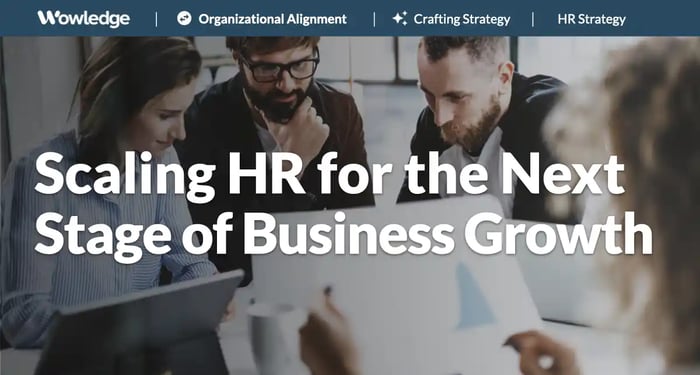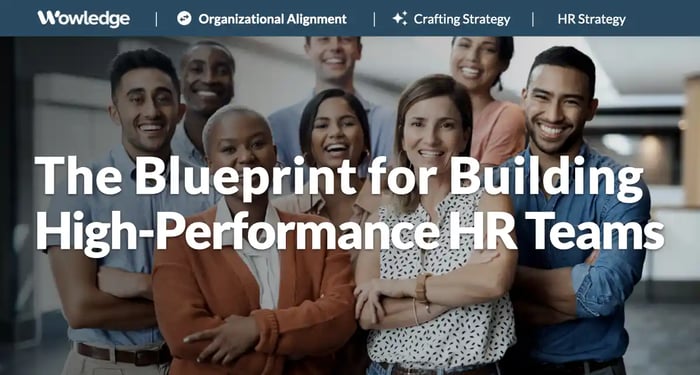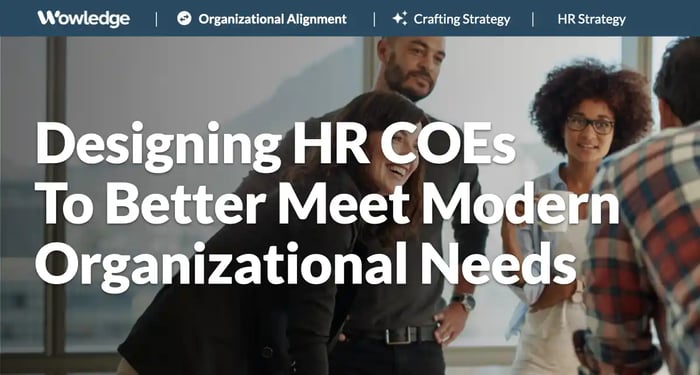Table of Contents
The organizational lifecycle is a mix of the predictable, along with encounters with barriers that require adaptation and difficult choices to stay on a healthy path to growth and sustainability. As a key function of any organization, HR must grow and expand its offerings in concert with critical business requirements. Making decisions related to what HR capabilities (policies, practices, processes, and platforms) to establish and the timing of introducing those are often challenging for many organizations. Scaling HR capabilities at the right time and place in an organization’s growth journey requires careful planning and thought, as the investments can be significant and the choices face resistance.
What is scaling HR and when is it needed
Scaling HR refers to the process of developing and expanding HR capabilities in a manner that is proportional to the operational needs and budget tolerance of the organization. It involves progressively building HR functionality that supports and accommodates the needs of a growing and maturing workforce and workplace. Scaling HR supports the increasing volumes of employees, employment-related transactions, company products and services, customers, and sales and support requirements. It is designed to meet the organization where it is going, creating management processes and systems that mature along with the increasing complexities that organizations face.
Scaling HR, much like the same growth that is needed in other corporate functions, is needed in response to increasing complexities facing the business due to:
- Organization sales, revenue, and customer growth
- Product, service, geographic market expansion
- Technological advances
- Industry trends and practice improvements
- Changes in strategic, operational directions, and priorities
- Changes in economic and labor market trends
- Introduction or changes in legal or regulatory requirements and environments
Any major shifts in organizational fortunes and requirements can create the need for either improving or adding HR functionality, related to its processes, practices, policies, and platforms (technologies). Understanding what related changes are needed, as well as how much, how soon, and how to implement those, is an essential and strategic element of HR planning.
The elements of scaling HR
Smaller organizations, such as start-ups or single-shingle, stand-alone businesses, are able to operate with fewer constraints, as they employ fewer people, and as a result, can be managed by fewer people who are often able to directly observe and supervise day-to-day operations, and have fewer legal risks. As organizations grow and mature, however, characteristic changes such as more employees and contractors, more customers, a wider range of products and services, more physical locations, and more geographic markets create substantially heightened complexities that make management more challenging.
Each of those characteristic changes introduces greater risks to sustainable operational performance, as well as increased expectations from customers, stakeholders (especially when external financing is required), employees, and legal and regulatory bodies. Six critical elements or considerations of scaling HR come into play, with each requiring ongoing attention by HR and business leaders.
Aligning with strategic business priorities
Scaling HR is a business-focused effort that requires ongoing alignment between the deployment of HR capabilities and the most critical business objectives. As such, any evaluation of the scale of an HR team relative to the business demands must start with a disciplined assessment of those requirements, followed by prioritizing and planning of HR direction and initiatives. The HR team must start with a review of the strategic plan and discussions with top leaders to ensure that HR capabilities and resources are in synch with business priorities, market conditions and shifts, functional requirements, and budget availability.
Standardizing policies
The most common element of scaling HR as an organization grows is the need for consistency of HR policy application and decision-making across the organization. Managers and employees expect to have basic rules and guidelines that establish how they will be managed and the standards against which their work and performance are evaluated. The need starts with legal and regulatory-driven policies responding to wage and hour (FLSA), anti-discrimination (EEO, ADA), health and safety (OSHA), leave and absence (FMLA), and benefits (ERISA, ACA, COBRA).
Beyond those, and as the workforce grows, a need expands to drive uniformity across individuals, teams, and locations in hiring requirements, performance standards, and criteria, and guidelines for how people will be managed and rewarded across the organization.
Maturing practices
As organizations and their operations evolve and add more experienced leaders and employees, their workflows can (and should) mature to mirror industry and career field leading practices. That type of growth is a key element to scaling HR, as a continuous improvement mindset can bring more sophistication to existing processes to drive greater talent and business impact. HR capabilities such as recruiting, performance management, and learning and development are characterized by a combination of practices that define the primary steps or actions that managers and employees take to complete a talent process (which in turn is how those are sequenced, including sub-steps that link the practices into a complete talent objective).
Practice maturation involves taking a progressive approach to improving efficiency and effectiveness over time, and can include introducing more meaningful interactions between managers and employees, leveraging technology, and tailoring them to meet unique organizational or targeted employee group needs.
Scaling HR practices in this way can be characterized as a strategic journey that can be viewed at three levels of maturity—core, advanced, and emerging.
- The initial design of a new HR function starts with the introduction of basic, or core practices that are established as foundational, upon which to grow and enhance over time. While strategic in nature, they are usually simple and easy to complete to achieve the desired talent outcome, such as assessing and selecting a qualified job candidate, teaching a manager how to deliver performance feedback in a constructive and motivating way, or assigning a salary range to a job. They tend to involve establishing a business purpose and a linkage between HR activities and operational strategies.
- The next step of practice growth or maturation involves the development of advanced practices or strategic HR capabilities, such as tailoring solutions that adapt leading practices to impact specified talent and business outcomes. Practices at this level commonly include the use of technologies and systems, advanced measurement and reporting, and leadership engagement in governance and oversight activities.
- At the highest level of sophistication is the adoption of leading-edge or emerging practices that drive significant impacts on critical talent and business objectives. These often include moving beyond practice standardization for every employee towards a tailoring of specialized versions of practices for strategically important critical workforce groupings, such as executives, sales, or product development engineers. They also create a focus on the most advanced capabilities, such as AI, culture development, and advanced statistical analytics, that integrate and predict the impact of strategic HR practices on business outcomes.
Optimizing processes
As organizations grow and expand, process design becomes more critical to meet the needs of a wider range of increasingly sophisticated employees across more functions and locations. Refining processes is crucial as standardization becomes more necessary and needs to drive fairness and equitable treatment, while still addressing the unique needs of different types of operations, work environments, career fields, and job levels. Process efficiency and effectiveness are also critical elements of the employee experience (EX), which drive employee productivity and engagement rates, as well as the candidate experience (CX) that directly impacts offer acceptance rates.
Adopting technology capabilities
Scaling HR is heavily influenced by the adoption of new or advanced HR systems, which, when well designed, properly configured, and implemented, bring tremendous advantages to an organization. Examples of opportunities that the introduction of technology into HR operations brings include a) automating processes for increased efficiencies, b) adopting advanced technologies to augment or replace less valuable human tasks, and c) enabling the generation of more objective, data-supported insights through reporting and analyses. Key considerations include providing access to all employees regardless of work location, integration across relevant HR systems, availability of mobile applications, and time during scheduled work hours to complete online tasks.
Updating the HR operating model and organization structure
Scaling HR often focuses on ensuring that the number of HR staff members is sufficient to meet operational requirements, but this is only one piece of the puzzle. In fact, while headcount is a consideration, more critical is the HR operating model, which defines how the HR function will deliver the necessary support and services. The model and resulting organization structure will determine the makeup and distribution of HR capabilities, with the objective of creating greater efficiency and more effective and timely support for employees at all levels.
To that end, scaling HR should include the redesigning of roles, reassignment of responsibilities, and redistribution of headcount, skills, and budgets to deliver operationally critical support in strategically targeted areas of the business. It should also bring considerations related to the need to develop and deliver new and enhanced HR products and service capabilities aligned with specified business objectives.

Indications of the need to scale HR
A number of early indicators can be used as signals that scaling HR may be required. To be fair and balanced, it is important to note that scaling HR can be an upward or downward decision, involving staff growth or cuts, functional expansions or consolidations (e.g., moving leadership development under the L&D professional or team), or technology-driven staff reductions (e.g., with the implementation of Agentic AI). In any case, changes in five key areas can provide advance notice of the need to reassess HR resourcing.
Volume changes
Significant increases or decreases due to organizational growth, expansion, or contraction of worker headcount, HR transactions to process, business expenses, sales and revenue, or the number of business units and locations. Any of these can indicate the need to reassess scaling HR.
Timeliness demands
Concerns about the speed of processing employee transactions or responding to new business requirements can indicate a need for improving the scale of HR. Consider the impact of slow or untimely HR process outputs, such as hiring, offboarding, training, and upskilling delivery, as well as responding to requests and inquiries from leaders, managers, and employees. When leaders and managers are dissatisfied with the lag time of data and reporting, just-in-time or real-time reporting is in demand in place of monthly or quarterly reports.
Efficiency pressures
Direction and required action from leadership, “to do more with less,” is a direct statement of the need for scaling HR. Business decisions related to operational staffing reductions, organization “flattening” (i.e., reduction of managerial levels), and increased cost and expense management controls are all indicators that reviewing HR resourcing may be required.
Quality issues
When the objective results, or feedback from leaders and employees about the design and delivery of HR services are below expectations, a need to reevaluate how those are being prepared and implemented may be necessary. Indications of the need to deliver more consistent, standardized, and reliable support and service should cue a formal evaluation of the deployment of capabilities. Other signals include the observations (or measured level) of processing, consultative, or design errors can reflect improper scaling of HR capabilities. Internal HR customers most often have expectations for fast, responsive, and trustworthy solutions and resolutions to their challenges.
Insufficient organizational flexibility and agility
In many industries and sectors where market and competitive volatility is common, such as technology, retail, and financial services, HR scaling can be a critical element of success. In start-ups and emerging companies, a similar lack of stability and predictability can require HR to be flexible and agile. As such, it can create an environment where enhanced adaptability in HR is required to meet rapidly changing circumstances and operational requirements. Shifting of HR staff members to a new product or business unit launch, budgets and resources to the closure of a failing facility, adding new HR capabilities in AI or analytics to support new directives, or realigning of HR teams to better match enterprise staffing of functions, business units, and locations are all potential flexes in HR scaling.
Each of these can be considered as operational indicators of a need to improve how and what HR might need to better support the business. What they will not specify is how many people might be needed to improve those outcomes. The use of industry benchmarking can be used to understand how similarly scaled (e.g., employee headcount, revenue, location(s), geographic dispersion) organizations in the same or related industries staff their HR teams. The metric that is most relied upon is the HR staff-to-employee headcount ratio, but other organizational research may be leveraged to identify the breakout of generalists to specialists, or by job function (e.g., compensation and benefits, learning, recruiting).

Key steps for scaling HR
Determining when and how to properly scale HR is a function of listening to leaders and their strategic needs, understanding the market, business, and talent trends affecting the organization, and being constantly attuned to signs that HR needs to optimize or add new expertise and capabilities to help the business achieve its objectives. While many HR teams feel overstretched and under-resourced, the elements of establishing the “right” level of HR scale are easily within reach. The challenge is determining what levers to pull to optimize HR efficiency, effectiveness, and business impact with the resources available. Key steps include:
1. Regularly assess the current HR capabilities against business needs
Understanding how HR is contributing to business objectives in an efficient and effective manner is only a start. It is also critical to establish where the business is going over the coming two to three years, and what resourcing and expertise the HR function will need to support that. Goals should be developed related to the talent and skills that the business needs to accomplish its objectives, and the HR resources needed to cultivate those.
2. Measure, analyze, and listen to leaders
Make evidence-based HR the standard for assessing business and operational needs. Be proactive and listen to leaders and managers to understand the issues and barriers they face to determine how HR expertise can be leveraged to support the achievement of their objectives. Seek to find the root causes of both business and HR or talent issues by ignoring the urge to accept surface explanations for organizational challenges—treat those as theories requiring further exploration and analysis. From that, determine what HR resourcing is required to support and overcome those challenges.
3. Decide how to scale the HR function
A key question to answer is what to scale—HR people, practices, processes, or platforms. Consider what will best support the increased volume, new business direction, or resolve the root cause of problems—more HR staffers? Better-skilled HR teams or line managers? A redesigned and streamlined process? An automated system that more efficiently collects, processes, and reports on trends in HR transactions? It could involve multiple choices from above. But what is crucial is conducting a disciplined analysis of what is really needed, and the cost-benefit of the available choices. Such a business case should be used to determine and communicate the extent to which the selected option will deliver the required level of value to the efficiency, effectiveness, and impact of the HR scaling issue under consideration.
4. Calibrate and evolve HR strategy
As an organization grows and faces increasing operational complexity, business and people challenges, financial and regulatory oversight, and competitive forces, it needs more sophisticated HR strategic approaches to address a multitude of unique needs. The starting point for scaling HR is an HR strategic plan, which focuses on aligning HR priorities with those of the business. Next, as the growth curve is starting, develop a talent strategy to determine the types and numbers of people to hire, and alternative options (e.g., contractors, consultants, temps) based on affordability and organizational capability needs.
As HR functionality expands, a talent management strategy can define how to most effectively integrate HR and talent processes and initiatives across HR teams. Finally, a critical workforce segmentation strategy can be developed to support the tailoring of budgets, resources, and initiatives to the roles and functions that are most strategically critical to the achievement of business objectives.
5. Add staff by needed capability and level of proficiency
Staffing decisions are typically the most expensive when scaling HR operations, as the costs are recurring and increase annually, and involve salary plus other expenses (e.g., bonuses, tax contributions, health and welfare benefits, office facilities, and computers and equipment). As a result, decisions need to be made regarding the individual capabilities and skills—whether they are ongoing or temporary, the combination of skills and experiences required, and the level of expertise and proficiency needed.
Start with the legally-required capabilities, such as in payroll, benefits, and health and safety, progress to the basics needed to staff and train new hires, then compensation, performance, strategy, and HR systems, and as the growth continues, on to reporting and analytics, career development, leadership and succession, and employee listening.
On an aggregated level, the make-up of the HR team should be driven by a combination of the capabilities needed and the number and level of people required to perform the necessary tasks. Consider the timeframe and nature of the business impact required, whether it is a design and implement (one-time) or a design, develop, and continuously refine effort that calls for temporary or “permanent” staffing.
6. Adapt the operating and organizational models
As the employee base and geographic locations grow, more opportunities present themselves to automate and introduce or mature the self-service model. Consider how the creation of a shared services organization can enable and introduce greater efficiencies, more consistency in policy and practice applications, centralized data collection and processing, and insight-generating reporting to bring a higher level of service to the organization.
Assess the opportunities for more strategic HR support by deploying fewer, but highly skilled HRBPs and smaller COE teams staffed with more senior, multi-functional experts assigned to broader targeted talent outcomes instead of traditional single-function groups (e.g., L&D, compensation, recruiting).
Relevant Practices & Tools
Core HR Strategy Practices to Define a Foundational Direction for the HR Function. >
An HR Strategy sets business-based human resource (HR) tactics that will constitute a comprehensive multi-year approach to managing the HR function's structure, governance, programs, policies, and practices... more »
Structuring the HR Organization to Best Meet Business Needs. >
The design of an HR organizational model requires considering a number of potential factors—the available HR budget, business organizational structure, business and HR strategic plans, critical workforce segments, and the company's culture... more »
Defining Recruiting Needs in Alignment with Business Strategy. >
A foundational element for effective recruiting strategy and sourcing is an attractive “Employee Value Proposition (EVP)” or “Employer Branding” that showcases where the organization stands in a number of key areas... more »
Tailoring Learning Offerings to Critical Workforce Segments for Increased Impact on the Highest Value Roles. >
A critical workforce segmentation involves identifying roles that disproportionately impact the organization's strategic goals... more »
The HR Business Challenge Goal Conversion Tool: Translate Identified Challenges into Clear and Distinct HR Goals. >
This tool is used in a sequence of analyses that convert key business objectives, external, and internal environmental scans into HR challenges that can subsequently be converted into HR goals and objectives... more »
About Wowledge
Wowledge is the implementation-first platform designed for lean HR teams and consultants who need to design and scale strategic HR programs efficiently—without starting from scratch.
Our members gain access to continuously updated best practices, step-by-step guidance, expert-built tools, and customizable templates—all structured to accelerate the development and implementation of key HR programs.
Recognizing that every organization operates at different levels of sophistication, Wowledge’s scalable system of best practices follows a stage-based approach—Core, Advanced, and Emerging—ensuring HR professionals can implement solutions tailored to their organization’s unique needs and goals.
Your Shortcut to Amplifying HR Impact!
Get started for FREE! Learn more.










